Every Honor Flight Vet Has a Story
Plattsburgh – At each North Country Honor Flight send-off ceremony at the US Oval Janet Duprey reads a military biography of each veteran being honored. She compiled these biographies for Honor Flights #34 and #35 that flew on Saturday, September 11, 2021.
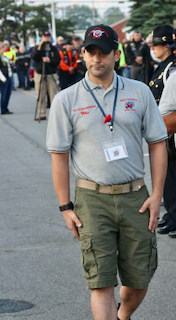 Wesley Black
Wesley BlackRamadin, Iraq, 2005, an anonymous tip on unexploded artillery sent 2 jeeps to investigate. They found 100 artillery shells and munitions as an IED explosive tossed the jeep Wes and others were riding in. The day before Wes received an experimental prototype gunner attention strap which allowed Wes to extend forward and then pulled back into the jeep. He suffered the loss of hearing in one ear and serious back injuries Had he not received that gunner attention strap, now installed in military vehicles, he would surely have been killed.
Wesley is a victim of the Iraq, Afghanistan Burn Pits. Soldiers generate lots of trash –electronics, plastics, batteries, human, medical and food waste – thrown in the trash dump, coated with diesel fuel and set on fire. Eastern Afghanistan pits were only 150 feet outside the gates Monthly, Wes and his comrades patrolled 3 weeks and one week they were assigned to gate guard duty spending 8-12 hours daily breathing in the carcinogens of the Burn Pit fires.
In a CNN interview, Staff Sergeant Wesley Black said “I’m just a dumb Irish kid from Boston” who has stage 4 cancer; who doesn’t know how long oral chemotherapy will keep him alive; but he’s going to put up ‘one hell of a fight’. At 35 years old, Wes knows life will be short. He wants to make good memories for his wife Laura and their 5-year-old son Ronan.
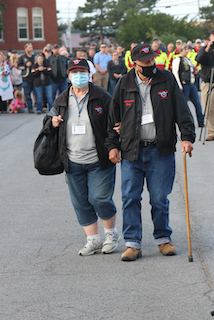 John Doten
John DotenArmy 1952-1954 Korean
During basic training in Fort Sill, Oklahoma, John became a Track and Maintenance Instructor. Going from California to Japan he taught maintenance and repairs on tanks. Their engineering troop was headed to the Korean line. Instead they went back to Japan to build a track vehicle school. John spent 18 months in Japan.
John fits right in with a great group here today as he currently owns 5 motorcycles even after one Harley Davidson was destroyed in a fire and another was stolen. John turns 91 in a couple of weeks so further proof, motorcycle guys never give up!
Alden Ehler
Air Force 1954-1959 Korean
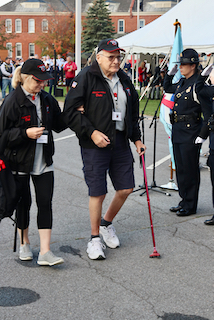 Alden, known as Duke, joined the Air Force but said he got ‘tossed’ to the Army in a Special Army-Air Force Category. He said they all wore Army uniforms, were surrounded by rice paddies and slept in tents in the field. But the men in Air Force uniforms stayed on the Base. Army leadership spent one year in Korea.
Alden, known as Duke, joined the Air Force but said he got ‘tossed’ to the Army in a Special Army-Air Force Category. He said they all wore Army uniforms, were surrounded by rice paddies and slept in tents in the field. But the men in Air Force uniforms stayed on the Base. Army leadership spent one year in Korea.Returning to the Air Force Base with the 19th Aviation Company Duke maintained equipment including rebuilding tanks on the battle fields. He said it was not a pleasant place to be.
Ronald Ewing
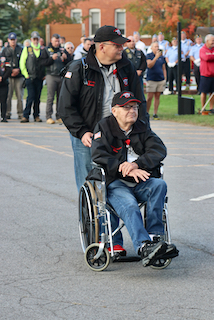 Air Force 1954-1957 Korean
Air Force 1954-1957 KoreanRon served in the 767th Air Control & Warning Squadron.
After military driving classes, he drove buses, semis, jeeps. He drove the bus for ball teams in New Mexico. He also drove to Santa Fe where atomic bombs were being made.
While doing night patrol in Oklahoma, Ron found rattlesnakes at the rear gates.
In Japan, Ron was the first to get through the door to take a seat on the bar stool. A guy hit him in the mouth, knocking out 3 front teeth. A quick learner, Ron wasn’t the first in the bar again.
Clarence Fournia
Navy 1950-1954 Korean
Clarence, also known as Joe, served on repair ships including the USS Cadmus with its homeport in Norfolk, VA. The sailors on the Cadmus were called to service ships that were in trouble along the east coast.
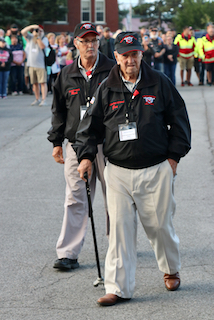 Most often Joe and his fellow sailors fixed leaking high pressure steam valves, and repaired boilers.
Most often Joe and his fellow sailors fixed leaking high pressure steam valves, and repaired boilers.As Castro began making noise to take over, the ships cruised the Caribbean. The crews focused on assuring the need for repairs were detected, fixed, and maintained in good condition in the event a battle occurred.
Stephen Gitto
Navy 1944-1947 World War II
Steve joined the Navy at 17. He spent most of his War time in England including the U.S. Air Facility 804, Dunkeswell, Devon. In London they were about 20 minutes from battles and bombings. London was in shambles.
Steve boarded the USS Helena to Scotland. The good news the ship had an operating room as Steve needed an appendectomy. The bad news the 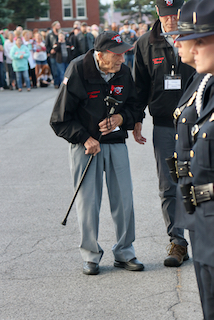 doctor was on another ship that didn’t have an operating room. The doctor was brought across rolling waves on a rope. Steve watched the doctor perform the appendectomy as the massive waves kept the boat heaving up and down. Steve is one of the first people to receive penicillin and the doctor didn’t know how much to give him. After 4 days of penicillin shots every 4 hours, Steve said stop as he was a pin cushion. While still recovering in Switzerland, he hobbledoff the ship to get a photo taken with a kilt on.
doctor was on another ship that didn’t have an operating room. The doctor was brought across rolling waves on a rope. Steve watched the doctor perform the appendectomy as the massive waves kept the boat heaving up and down. Steve is one of the first people to receive penicillin and the doctor didn’t know how much to give him. After 4 days of penicillin shots every 4 hours, Steve said stop as he was a pin cushion. While still recovering in Switzerland, he hobbledoff the ship to get a photo taken with a kilt on.
 doctor was on another ship that didn’t have an operating room. The doctor was brought across rolling waves on a rope. Steve watched the doctor perform the appendectomy as the massive waves kept the boat heaving up and down. Steve is one of the first people to receive penicillin and the doctor didn’t know how much to give him. After 4 days of penicillin shots every 4 hours, Steve said stop as he was a pin cushion. While still recovering in Switzerland, he hobbledoff the ship to get a photo taken with a kilt on.
doctor was on another ship that didn’t have an operating room. The doctor was brought across rolling waves on a rope. Steve watched the doctor perform the appendectomy as the massive waves kept the boat heaving up and down. Steve is one of the first people to receive penicillin and the doctor didn’t know how much to give him. After 4 days of penicillin shots every 4 hours, Steve said stop as he was a pin cushion. While still recovering in Switzerland, he hobbledoff the ship to get a photo taken with a kilt on.Steve played the trumpet in the Naval Band. He traveled with American Admiral H.R. Stark on a Good Will Tour after the War going to several bases in France, Spain, Germany, Gibraltor.
Steve began playing trumpet at 12. In 1952 he began teachingtrumpet to students. This summer, he played 9 concerts with the Chatham Community Band. The final concert was dedicated to Steve.
After the concert, Steve was surprised to see a former trumpet student John Bass, former Ambassador to Afghanistan, recently appointed Under Secretary of State approach him for a great visit.
We are honored to have 95-year-old World War II Veteran Steve Gitto join our Honor Flight Family.
Cameron Herdman
Army 1956-1985 Vietnam
Cameron was drafted in 1955 but he received a farm deferment. He began active service in 1956. Cameron was stationed at Fort Hood, Texas when the Red Cross assisted with a hardship deferment due to the death of his father.
 With a smile, Cameron said he was directed to join the Army Reserves or go to jail. He said joining the Reserves was the best thing that ever happened as he spent 28 years going up the ranks in nursing.
With a smile, Cameron said he was directed to join the Army Reserves or go to jail. He said joining the Reserves was the best thing that ever happened as he spent 28 years going up the ranks in nursing.A member of the Medical Unit, he was a Chief Ward Master in the Malone Reserve Center.
Bruce Allen — Veteran Guardian for Cameron Herdman
Army 1967-1969 Vietnam
After basic training at Fort Jackson, South Carolina, Bruce attended medical training in San Antonia, Texas. He was a Specialist Medical Corpsman.
As an orthopedic specialist, Bruce worked at the William Beaumont General Hospital in El Paso, Texas treating soldiers returning to the states from Japan. He applied many Plastic of Paris casts and splints under doctors’ supervision.
Bruce turned down Officers’ Candidate School and spent his last 6 months of service as the non-commissioned officer in charge of orthopedic rooms.
William Holzer
Army 1956-1958 Vietnam
After basic training at Fort Knox, Bill trained in heavy weapons at Fort Hood.
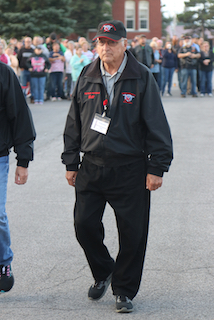 Bill spent 18 months at Fort Shafter, Hawaii, with the 524th Military Police. The centerpiece of Fort Shafter is Palm Circle includingthe National Memorials and the National Memorial Punchbowl Cemetery. It’s estimated over 53,000 U.S. veterans from World War II, Korean and Vietnam Wars are buried there along with Ernie Pyle, Pulitzer prize correspondent. No cemetery stones or crosses are allowed.
Bill spent 18 months at Fort Shafter, Hawaii, with the 524th Military Police. The centerpiece of Fort Shafter is Palm Circle includingthe National Memorials and the National Memorial Punchbowl Cemetery. It’s estimated over 53,000 U.S. veterans from World War II, Korean and Vietnam Wars are buried there along with Ernie Pyle, Pulitzer prize correspondent. No cemetery stones or crosses are allowed.13 Generals lived on Palm Circle and Bill said when the Generals pulled up to the gate, the Military Police just let them through.
Linus Kinner
Army 1952-1954 Korean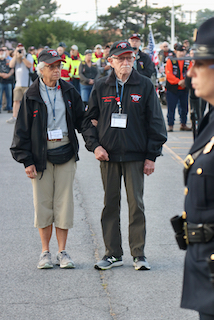

Upon arrival in Tokyo Linus was given 3 choices: Infantry, Signal Corp or Medical Aid Man. After medical training at Eta Jima, Japan, he was immediately sent to the Demilitarized Military Zone.
Linus was injured by mortar shrapnel and transferred to Osaka to recover after Mash surgery.
Flying to the United States on military transport, a stowaway was discovered. They turned back to Tokyo, handed the stowaway over to police, got a new plane, and were on the way home to the States
50 years later, Linus and his wife Judith went to Tokyo and were treated like Royalty.
Ora Paul
Army 1952-1954 Korean
Ora was a member of 1821 Company B 13th Engineer Company Battalion. He was the Unit Supply Specialist in charge of supplies for the company.
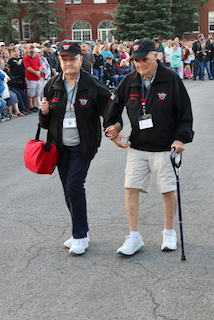 Ora was stationed at the Demilitarized Military Zone when the Infamous Pork Chop Hill bombardment took place. The 2nd battle involved many troops on both sides. The battle was bitterly contested for 5 days with heavy artillery back and forth 24 hours a day.
Ora was stationed at the Demilitarized Military Zone when the Infamous Pork Chop Hill bombardment took place. The 2nd battle involved many troops on both sides. The battle was bitterly contested for 5 days with heavy artillery back and forth 24 hours a day.When the battle finally ended, Ora couldn’t sleep for 3 days.
Robert Peacock
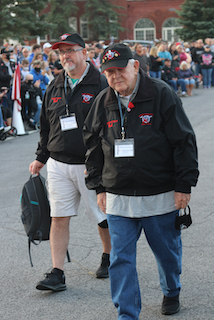 Air Force 1958-1978 Vietnam
Air Force 1958-1978 VietnamAfter basic and Police Academy training, Bob went to Okinawa for 18 months.
In 1962 stationed at Plattsburgh Air Force Base Bob met his wife Irma on a blind date.
Bob was in the 1968 TET offensive and was thankful every day that he survived the 24 hours before. In 1969 Bob joined the 377th Security Police Squadron, the largest Police Outfit in Vietnam.
Assigned to Hickam Air Force Base Hawaii he greeted the returning Vietnam Prisoners of War. Back in Plattsburgh, Bob retired and became a Clinton County Deputy Sheriff.
Gary Tamer
Navy 1966-1970 Vietnam
Gary served on two ships: USS Fidelity and USS Parrot. He spent 19 months at the Military Sea Transportation Service Office, Vung Tau, Vietnam.
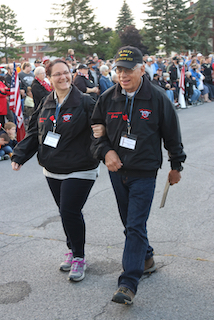 A Supply Storekeeper in Saigon, Gary shipped military cargo by civilian transport as some U.S. Naval ships were decommissioned. Assigned to a clerical position Communications Yeoman, Gary composed messages using encrypted teletype; composing highly classified messages on ship movements, location of ammunition ships and protecting armed personnel.
A Supply Storekeeper in Saigon, Gary shipped military cargo by civilian transport as some U.S. Naval ships were decommissioned. Assigned to a clerical position Communications Yeoman, Gary composed messages using encrypted teletype; composing highly classified messages on ship movements, location of ammunition ships and protecting armed personnel.Gary is proud to have received the top grade of 4.0 for his supply store achievements.
Frederick Woodward
Navy 1960-1966 Vietnam
Fred tested experimental equipment corporations and other countries wanted to sell to the Navy.
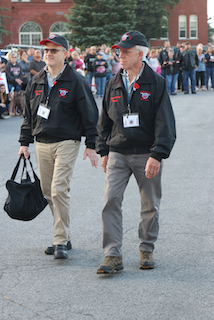 A radio operator, Fred was on the USS Glennon DD840 to record conversations from Astronaut John Glenn. Given an unused frequency Fred heard nothing, but it was an exciting experience.
A radio operator, Fred was on the USS Glennon DD840 to record conversations from Astronaut John Glenn. Given an unused frequency Fred heard nothing, but it was an exciting experience.Fred was involved in the rescue and recovery of the Submarine Threshold but there was no rescue or recovery – only marking the site off the Massachusetts coast.
During the Cuban Missile Crisis, Fred was aboard a ship tracking the Russian ships. There was no engagement thanks to the negotiations between President Kennedy and Premier Khrushchev.
Ralph Wurtz
Air Force 1960-1980 Vietnam
Early in his Air Force career, Ralph was stationed in Germany for four years where he met and married his wife.
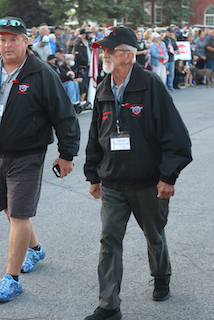 At McConnell Air Base, Kansas he trained as an Aerospace Ground Equipment Repairman or AGE mechanic. Ralph said they repairedgenerators, air compressors, heaters and anything else needing repair.
At McConnell Air Base, Kansas he trained as an Aerospace Ground Equipment Repairman or AGE mechanic. Ralph said they repairedgenerators, air compressors, heaters and anything else needing repair.He served in Thailand and Vietnam with a TDY in Korea.
Stationed for another 5 years in Germany Ralph returned to the States. After 20 years of service, Ralph retired from Plattsburgh Air Force Base, and worked as a civilian on base until it closed in 1995.
Honor Flight #35
Ronald Badger
Army 1965-1969 Vietnam
Ron enlisted in the Army National Guard serving with the Green Mountain Movers, 131st Engineers in Vermont. When the Unit was deployed to
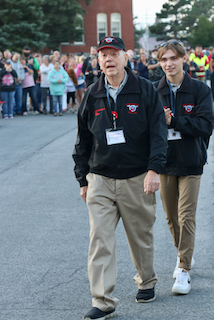 Vietnam, Ron was with the Advance Party sent to set up camp for the remaining Company members
Vietnam, Ron was with the Advance Party sent to set up camp for the remaining Company membersDeparting from the plane, they were loaded into a deuce and a halfas they proceeded through the rice paddies. They were issued M16weapons but no ammunition. Thankfully the advanced team was not fired on. The memory of that experience has stayed with Ron!
A member of American Legion Post 912, Ron has been raising the flag at our ceremonies. We’re so pleased he’s going on this flight.
Raymond Barnes
Army 1954-1956 Korean
Ray was assigned to Headquarters Detachment 29th Engineer Battalion. In 1954 the Battalion assumed responsibility for Korea and Okinawa and
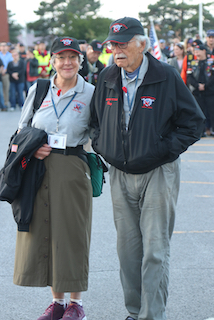 moved to Tokyo, Japan to provide topographic support for U.S. and Allied Forces in the Pacific
moved to Tokyo, Japan to provide topographic support for U.S. and Allied Forces in the PacificUsing an Island observatory, Ray and other Topography Computers watched for the point international time signals triangulated to each citing.
Ray said this was all top secret and they were not to talk about it until he got home and read about it in the newspapers. Government in action!!
Donald Bradley
Air Force 1950-1954 Korean
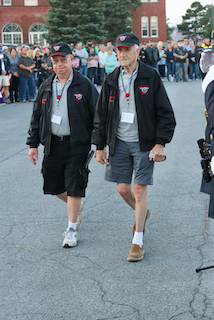 A member of the Air Police, 76th Communications Squadron, Don wanted to join the flight service. Because he is color blind he couldn’t go.
A member of the Air Police, 76th Communications Squadron, Don wanted to join the flight service. Because he is color blind he couldn’t go.Don was in Korea for 17 months. They lived in 16 Quonset Huts which were definitely not comfortable living quarters. The Air
Police secured trains taking supplies to the rear lines and provided security to radio towers on top of mountains. At Dageau Air Force Base, known as K-2, in South Korea, Don said it was phenomenal to watch the jet planes take off 2 at a time up to 20 times a day.
Ronald Chase
Army 1967-1969 Vietnam
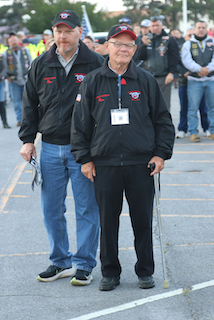 Ron was assigned to the 1st Battalion – 5th Artillery also known as the Big Red One.
Ron was assigned to the 1st Battalion – 5th Artillery also known as the Big Red One.Arriving in Vietnam, the troops were transported on Schanook trains loaded with jeeps. The vibration of the jeeps was unmerciful. They went through elephant grass that was way over their heads and the troops knew Charlie was waiting.
Ron fell in love with the kids, but as with his fellow soldiers too many little boys were killed in the nights by the Vietcong.
Ron will never forget landing at the California airport, being spit on and called a baby killer. Tough memories linger on.
Paul Costin
Army 1963-1966 Vietnam
Paul was stationed at Zweibruken Air Force Base, Germany. He was a cook and also maintained the warehouse lists and collected all the food.
Paul qualified as an expert rifleman and participated in bivouac. The Black Forest served as a training ground for war games. If a soldier came against chalk on the side of a truck, the opposing side had him.
When Russian vehicles were on the road, the U.S. troops were to pull over and wait until the Russians left. Often the Russians kept count of the U.S.  license plates which Paul described as a bit scary.
license plates which Paul described as a bit scary.
 license plates which Paul described as a bit scary.
license plates which Paul described as a bit scary.Robin Schwartz Veteran Guardian for Paul Costin
Army 1979-2012 Cold War
Rob was a Combat Engineer who served at many bases during his career.
In Boise, Idaho he did route clearance with hummers to clear the roads. As a resident expert for unit training, Rob addressed issues of nuclear, biological and chemical hazards.
Rob was a Military Instructor who taught ROTC students, and West Point cadets during the summers on basic rifle managementand obstacle and small group courses. He also taught professors to develop courses for Non-Commissioned Officers. Rob retired after 33 years of military service to our Country.
Darrell Dailey
Army 1969-1984 Vietnam
Darrell completed a 20-week course on conventional and nuclear weapons to become a member of the 85th Explosive Ordinance Disposal Team.
Darrell was in a 12-man unit in a demolition squad. When the Company Commander needed security a 2-man team would go and sometimes a 6-man team was dispatched.
They put out booby traps, roadside bombs, and grenades in particular spots. At night they placed chargers, and timers on bombs and went back in the morning to see if any had been blown up. While searching one morning sadly a Sergeant became a victim of a bomb.
Lawrence Douglas
Army 1961-1963 Vietnam
 Larry was assigned to the 310th Field Hospital. On realizing he could type, he became a General Clerk processing orders for fire service, draftees, and enlisted personnel.
Larry was assigned to the 310th Field Hospital. On realizing he could type, he became a General Clerk processing orders for fire service, draftees, and enlisted personnel.At the Armed Forces Enlistment Station in downtown Philadelphia, he processed physicals, testing, and cut orders for Army and Air Force draftees headed to Fort Dix.
Larry said it was great duty with public relations including the USO, huge City parades, parties at hotels with Colonels and Generals AND he got tickets to the NBA Phillies’ games.
Larry also worked with the Red Cross and served as an Honor Guard at funerals.
John FitzGerald
Air Force 1949-1969 Vietnam
John was a Flight Engineer with the 4603 Aircraft Maintenance Squadron.
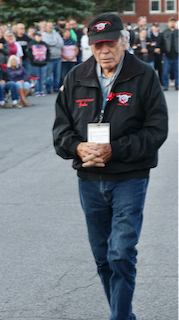 In Vietnam they fixed planes at night, got to the barracks at 6:00 a.m., lunch at noon and at 4:00 guys were pushed to go on the Ho Chi Min Trail.
In Vietnam they fixed planes at night, got to the barracks at 6:00 a.m., lunch at noon and at 4:00 guys were pushed to go on the Ho Chi Min Trail.There were plenty of planes to work on such as patching holes in a C-47. The pilot wanted to fly home – the plane crashed on take-off.
A British Camberra bomber got stranded on the air strip at 2:00 in the morning. They had dropped their bombs but on landing the fuel tank fell off. John and crew moved all the other planes , worked on the British plane until it was ready to go.
Lots of dangerous excitement – too little sleep.
Terry Flatt
Navy 1968-1969 Vietnam
Terry received basic training at the Great Lakes. The recruits qualified on the Old Springfield and he was worried about jumping off a 10 meter (30 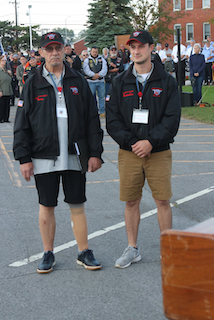 foot) high tower into the water. Tying his bell bottom legs turned them into a buoy. Some of the guys who couldn’t swim got thrown out of the boat – guess that’s swim or sink time.
foot) high tower into the water. Tying his bell bottom legs turned them into a buoy. Some of the guys who couldn’t swim got thrown out of the boat – guess that’s swim or sink time.
 foot) high tower into the water. Tying his bell bottom legs turned them into a buoy. Some of the guys who couldn’t swim got thrown out of the boat – guess that’s swim or sink time.
foot) high tower into the water. Tying his bell bottom legs turned them into a buoy. Some of the guys who couldn’t swim got thrown out of the boat – guess that’s swim or sink time.Terry was stationed at Andrews Air Force Base. He was with the Honor Guard for pomp and ceremony parades every weekend. A Lieutenant taught him how to twirl a rifle.
An invitation from Chief of Staff Westmoreland brought Terry to the White House for a ceremony held by President Johnson.
Earl LaVoie
Air Force 1948-1952 Korean
Earl enlisted in the Air Force as the Korean War was starting and President Truman extended his time an extra year.
 He was in a Medical Unit headquartered at Colorado Spring Air Force Base. The new base was being established as an Air defense command. They also were suppose to build bombs but that didn’t get done. Earl served in the Air Surgeon’s office. With no accommodations on the Base Earl stayed in a hotel.
He was in a Medical Unit headquartered at Colorado Spring Air Force Base. The new base was being established as an Air defense command. They also were suppose to build bombs but that didn’t get done. Earl served in the Air Surgeon’s office. With no accommodations on the Base Earl stayed in a hotel.He was given an application for college and Officer Candidate’s School but he turned them down. Earl attended The University of Maryland receiving his degree in business and Public administration
Anthony Prinsen
Army 1966-1969 and 1971-1976 Vietnam
Upon high school graduation, Tony’s father asked him what he intended to do with his life. Tony thought about his schoofriends who were a group 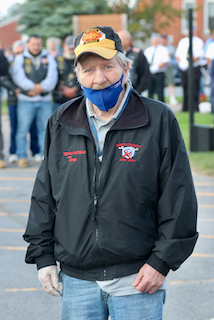 called the North Country Platoon.
called the North Country Platoon.
 called the North Country Platoon.
called the North Country Platoon.They went together to the Recruiting Station to sign up. The military put the Platoon up in Albany for the night awaitingtheir physical the next day. They went out that night, had too much to drink and all failed the physical. They repeated their antics until the 3rd try they passed the physical. Instead of riding the bus north, they headed south to Fort Dix.
Tony was a Lineman with his final tour of duty Germany.
Albert Sheffer
Army 1955-1964 Korean
Going to basic training at Fort Jackson, South Carolina, It was Al’s first plane ride. The side of the plane caught on fire so they landed in Virginia. They put out the fire and continued on the same plane.
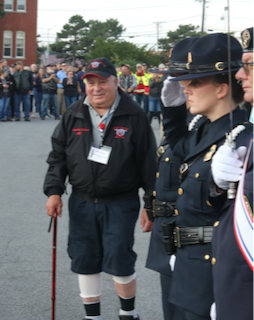 A member of the 106 Airborne Support Unit, Al maintained heavy road equipment and generators. At the Demilitarized Military Zone north of Seoul, Korea there was no electricity so they used the generators at night to produce light.
A member of the 106 Airborne Support Unit, Al maintained heavy road equipment and generators. At the Demilitarized Military Zone north of Seoul, Korea there was no electricity so they used the generators at night to produce light.Ending as he began, heading back to the States in an old plane, one engine quit at the end of the runway and the plane shut down.
Al, we promise you a better flight today!
Robert St. John
Air Force 1970-1974 Vietnam
A member of the 432nd Field Maintenance Squadron, Robert became a master at packing parachutes.
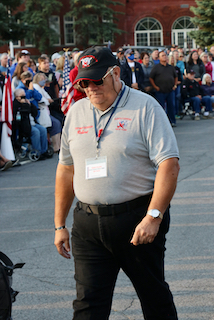 In the Mojave Desert a Master Sergeant was testing a parachute which failed. Using a reserve parachute packed by Bob worked. Returning to base, Master Sergeant went to the Parachute Shop presenting Robert with a bottle of champagne.
In the Mojave Desert a Master Sergeant was testing a parachute which failed. Using a reserve parachute packed by Bob worked. Returning to base, Master Sergeant went to the Parachute Shop presenting Robert with a bottle of champagne.In Thailand a pilot stationed at Udorn sustained battle damage to the aircraft. The parachute packed by Robert allowed the pilot to return safely to Base and he, too, gave Bob a bottle of champagne.
Is there a pattern here?
Clinton County American Legion and Rouses Point 912 Post Commander Robert St. John has been at every Honor Flight ceremony with the Honor Guard. We are delighted to have Bob on this flight.
Gary St. Pierre
Navy 1963-1965 Vietnam
Gary served at Naval Air Station, Whiting Field, Florida performing internal base security with 45 pistols and shot gun rifles. They patrolled the base 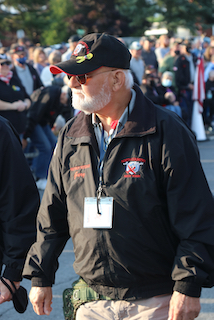 perimeters, staffed the main gates and ran the brig escorting prisoners from one base to another and to hearings.
perimeters, staffed the main gates and ran the brig escorting prisoners from one base to another and to hearings.
 perimeters, staffed the main gates and ran the brig escorting prisoners from one base to another and to hearings.
perimeters, staffed the main gates and ran the brig escorting prisoners from one base to another and to hearings.Gary participated in cordoning off plane crashes as they were first on the scene. Some crashes were really hard to cope with. The biggest challenge was keeping reporters out.
Boarding USS Bennington to the South Pacific as an Aviation Boatsman Mate Gary prepared aircraft on the flight deck.
Posted: September 21st, 2021 under General News.
